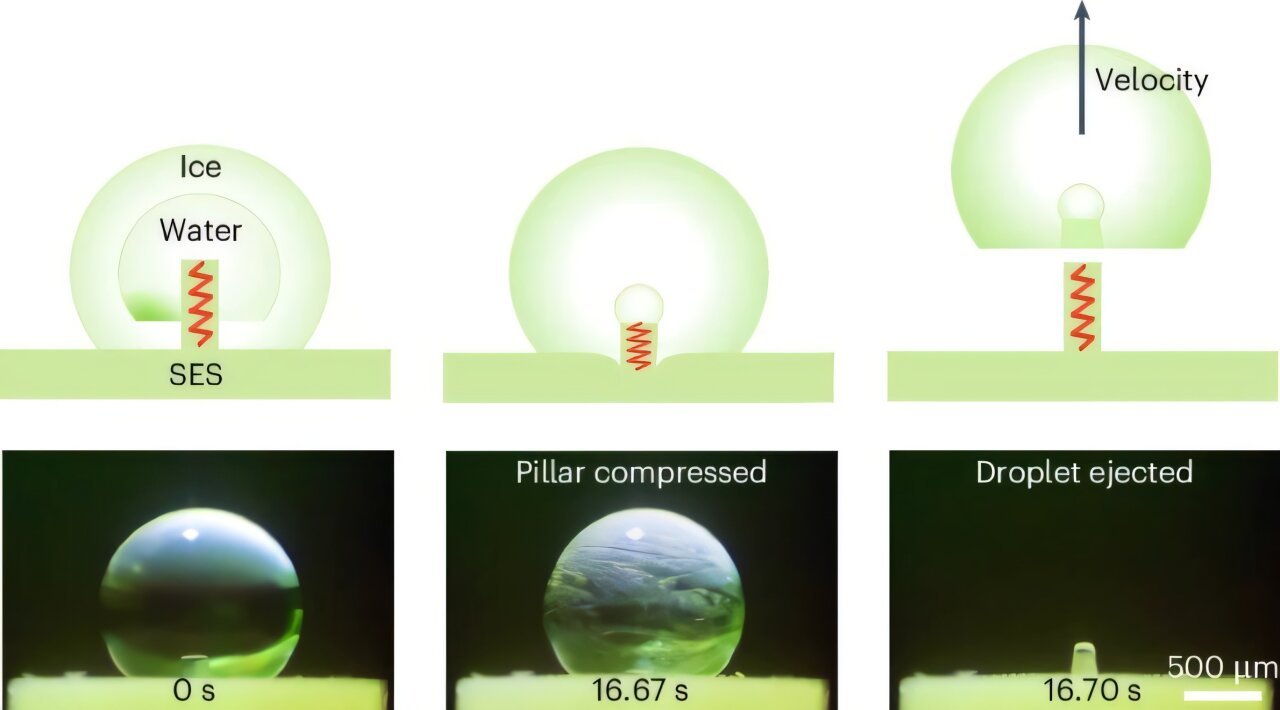Water droplets, when exposed to freezing conditions, tend to stick to surfaces due to stronger droplet-surface interactions, unlike at room temperature where droplets easily detach. This phenomenon poses significant challenges in various industries where accumulated ice or droplets need to be removed manually or with mechanical tools—an expensive and inefficient process. From aircraft wings to wind turbines and power lines, ice accumulation can create safety hazards, reduce energy efficiency, and lead to significant maintenance costs. As a result, preventing the formation and accumulation of ice has become a critical issue both from scientific and practical perspectives.
Recently, researchers at The Hong Kong Polytechnic University (PolyU) have discovered a remarkable mechanism that allows freezing droplets to shoot themselves away from surfaces without any external energy source. This self-powered process could revolutionize how we deal with the accretion of ice in various sectors, offering a potentially cost-effective and efficient method of dealing with freezing droplets in a range of technologies.
The Pioneering Research
Published in the December issue of Nature Chemical Engineering as the cover feature, the study titled “Freezing droplet ejection by spring-like elastic pillars” is the brainchild of a talented team at PolyU, led by Professor Zuankai Wang and Professor Haimin Yao. Prof. Wang, Associate Vice President of Research and Innovation and Kuok Group Professor in Nature-Inspired Engineering, is the driving force behind the project. He, along with Prof. Yao, Associate Professor at the PolyU Department of Mechanical Engineering, guided the groundbreaking research, which introduces a new way to address the ice accumulation problem with self-ejecting freezing droplets.
The study was co-authored by several talented researchers, including Dr. Huanhuan Zhang, Postdoctoral Fellow at PolyU, Mr. Wei Zhang and Mr. Chenyang Wu, Ph.D. students, and Dr. Yuankai Jin, Research Assistant Professor at PolyU. The success of this study has far-reaching implications not only for the future of de-icing technologies but also for other areas such as energy harvesting and soft robotics.
The Fascinating Inspiration: Nature’s Ingenious Design
The idea of using volume expansion to cause the ejection of freezing droplets was inspired by the natural world. Prof. Wang and his team drew inspiration from a remarkable phenomenon found in fungi. Certain types of fungi can shoot their spores away from the parent organism through a process of osmosis-induced volume expansion. As water enters the spores, the volume increases, and this expansion results in the spores being ejected at high velocity.
When Prof. Wang’s team observed the process of water freezing into ice, they realized that a similar phenomenon occurs. As water turns into ice, it undergoes volume expansion—this expansion could, theoretically, be harnessed to create a force strong enough to shoot the droplet off a surface. Inspired by this mechanism, the PolyU research team replicated the self-shooting behavior of spores and applied it to freezing water droplets.
The team developed a novel engineered surface called Structured Elastic Surface (SES), designed with spring-like pillars to capitalize on the energy generated during the freezing process.
The Mechanics of Freezing Droplet Ejection
At the heart of this breakthrough is the SES structure, which uses specially designed elastic pillars to facilitate the spontaneous ejection of freezing droplets. The pillars on the surface are not rigid—rather, they act like springs. When a freezing droplet begins to expand in volume as it freezes, the expansion of the droplet compresses these pillars. This compression converts the volume expansion of the freezing water into elastic energy stored within the pillars. This energy is quickly released in the form of kinetic energy, which propels the droplet away from the surface in a powerful jet-like motion.
The transition from stored elastic energy to kinetic energy occurs within mere milliseconds, creating enough force to eject the frozen droplet even against opposing forces such as gravity or wind. The effectiveness of the SES is remarkable because it works without any external energy input—meaning the freezing droplet “powers” its own ejection process. This development has the potential to significantly reduce maintenance costs for systems affected by ice accumulation and to create safer working environments in adverse weather conditions.
The SES structure was carefully designed through a process of parameter optimization, ensuring that it can be scaled up and manufactured inexpensively, which could make it a practical solution in a wide array of applications.
Potential Applications
The implications of this discovery are vast. The team’s self-powered freezing droplet ejection mechanism opens up a wide array of potential applications across industries. One of the most immediate and critical areas of application is in de-icing technologies. Aircraft, wind turbines, and power transmission lines are often vulnerable to the buildup of ice, which can lead to flight hazards, reduced energy efficiency, and maintenance challenges. The ability to effectively eject freezing droplets from surfaces, without relying on external power sources or manual labor, offers significant cost-saving potential and improved safety.
Beyond the conventional de-icing applications, the principle of freezing droplet ejection could also be applied to new technologies such as energy harvesting systems and soft robotics. Prof. Wang and Prof. Yao foresee a future in which the self-powered ejection concept could inspire new ways to harness and utilize energy from droplet movement, or even potentially power autonomous robotic systems, such as soft robotic catapults.
Scalability and Future Prospects
An important feature of this self-ejecting freezing droplet mechanism is its scalability. The team believes that, with further optimization, the SES can be manufactured at various scales and at a relatively low cost. This opens up the possibility of widespread implementation in a range of industrial and commercial applications, from transportation (e.g., preventing ice accumulation on airplanes and vehicles) to energy (e.g., efficient energy transfer in wind turbines) and beyond.
Additionally, the theoretical model developed as part of the research offers an invaluable framework for understanding the specific factors that influence the success of freezing droplet ejection. This will aid in the ongoing development of the SES structure and its ability to perform in a wider range of environments.
Dr. Huanhuan Zhang expressed excitement over this breakthrough, stating, “For the first time, we have introduced a self-powered ice removal concept that will offer innovative solutions across various industries. We are committed to continuously improving the design of SES, ensuring it is scalable, cost-efficient, and adaptable to societal needs.”
Beyond De-Icing: New Frontiers for Soft Robotics and Energy Conversion
Beyond its applications in ice removal, the principles of this research could also be extended to soft robotics, energy conversion, and other fields. The fact that freezing droplets generate kinetic energy upon ejection opens the door to potential new forms of energy harvesting. Prof. Wang explained, “We believe that this research, inspired by nature, could lead to the development of self-powered concepts for diverse purposes, including energy harvesting, soft robotic applications, and more.”
Prof. Yao further elaborated on the broader implications of the work. He emphasized that the team’s research not only demonstrates how to harness the volume expansion work of freezing droplets to generate motion but also presents a strategy for improving energy conversion phenomena across various platforms. This could lead to the development of droplet-based energy generators or even catapult mechanisms that utilize the expelled energy of freezing droplets.
Conclusion
The groundbreaking work conducted by researchers at The Hong Kong Polytechnic University marks a significant leap in both the understanding of multi-phase freezing dynamics and the development of self-powered systems. The simple, yet effective SES technology promises to bring a new era in efficient anti-icing methods, with direct benefits in transportation, energy, and even advanced robotics.
As the PolyU team continues to refine the design of SES and explore its potential applications, the concept of freezing droplet ejection could usher in a new generation of technologies that are not only more efficient and cost-effective but also better aligned with sustainability goals, reducing the reliance on external power sources in areas where ice accumulation remains a significant challenge. With continued research and development, this novel, nature-inspired method holds the promise of transforming multiple industries, making it an exciting development in materials science, mechanical engineering, and beyond.
Reference: Huanhuan Zhang et al, Freezing droplet ejection by spring-like elastic pillars, Nature Chemical Engineering (2024). DOI: 10.1038/s44286-024-00150-1






